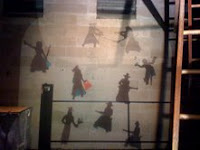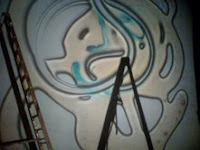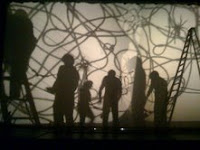A guest blog series by Christina Gutierrez, a Ph.D. student in Performance as Public Practice at UT Austin
Desert Voodoo

In the middle of constructing a giant laundry line suspended between two eighteen foot ladders and hung with everything from large cotton bloomers to silk slips to a feather boa with a giant plastic bird’s head at one end, during Tuesday’s I’ve Never Been So Happy workshop, we realized something about the nature of the world we’ve been creating. The gender politics of the West can be a bit hairy. In imagining the exclusively females space of Julie and her sisters in the first scene, we’d been drawn to the images of the wash lines we’d thought would make interesting alternative projection spaces. As conversation continued about the “world of women,” however, a few of us became uncomfortable with immediately associating women with washing. Later, we worked to create female silhouettes from plastic cowboy and Indian dolls, challenging the expectations we have of these toys and our gendered understanding of them. Part of the work of this process is finding interesting and nuanced ways to both challenge and embrace our understanding of the West and all of its implications.

By calling the time we spend in the UT Payne theatre a workshop rather than a rehearsal period, Rude Mechs has allowed space to make these kinds of discoveries. Sometimes, as with the ill-fated washing line, our playing with images, sounds, ideas, text, and movement leads us to near-immediate conclusions. Other times, however, the answers are not as immediately apparent. We spent a good portion of Tuesday afternoon lying on our backs on the Payne floor, watching as Erin riffed on projected images of landscape and the desert night sky created with dish soap, food coloring and India ink. Rather than immediately trying to ground the beautiful and provocative images in the text, we tested possibilities, learning how substances interact with each other on a projector, and what associations we have with them on a screen. Wednesday will bring a more structured storyboarding process, but the work we will do then will only be possible after Tuesday’s science experiments.

We played quite a bit on Tuesday with perspective and scale, using the Payne stage’s cyc as a giant projection screen that we could use to create a version of the knot that Julie and her sisters use to tie Jeremy to his lion that consumes the entirety of the space. In imagining the opening scene, we learned that perspective and audience placement will be crucial. The Rude Mechs’ December workshop in The Off Center began with a Western performance party (including costumes, margaritas and a talking bobcat) before the show that allowed the audience to participate in the art making process. The start of the show, the overture, made the transition from the interactive world of the performance party and the projected/choreographed world of the play nearly seamless. The University of Texas Payne Theater is a more or less traditional proscenium space leading us to experiment with outside the confines of The Off Center’s black box. Maybe the audience’s trip from the lobby to the house to the stage can lead them deeper and deeper into our version of the West. We hope our projected world will open into the live action of the piece, but the audience’s experience of the projected images will be the key to understanding the story.
All of our work for the past two days has been underscored by Peter Stopschinski and Lyn Koenning’s work with the singers who will voice Julie and her sisters in the first scene. As the week progresses, I look forward to integrating their haunting vocal work with our image work, and the choreography we’re developing with the ropes and ladders. As we continue to discover, in this West, everything’s tied.
